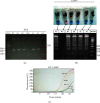Noninvasive Approach of Plasmodium falciparum Molecular Detection for Malaria Surveillance in Malaria Endemic Areas in Cameroon
- PMID: 36408284
- PMCID: PMC9668469
- DOI: 10.1155/2022/3600354
Noninvasive Approach of Plasmodium falciparum Molecular Detection for Malaria Surveillance in Malaria Endemic Areas in Cameroon
Abstract
Background: Accurate, cost-effective, and noninvasive alternative molecular methods are needed for detecting low malaria parasitemia. The currently-used nested polymerase chain reaction (nPCR) requires blood as well as skilled personnel in order to minimise the risk of bloodborne disease transmission. Therefore, this study is aimed at assessing the accuracy of a noninvasive and more affordable malaria diagnosis with saliva using the loop-mediated isothermal amplification (LAMP) technique.
Methods: A cross-sectional study was conducted in the Centre and Southwest regions of Cameroon. Matched blood and saliva samples collected from symptomatic and asymptomatic participants were tested for malaria using rapid diagnostic tests, microscopy, PCR, and LAMP. Statistics were performed using R studio software at 95% confidence interval.
Results: A total of 100 participants (65% symptomatic and 35% asymptomatic) aged between 1 and 74 years with a balanced gender distribution ratio of 1.08 were included in our study. The prevalence of malaria was 61%, 57%, 59%, 42%, 35%, 17%, and 16% for blood-RDT, blood-PCR, blood-LAMP, blood-RT-LAMP, saliva-PCR, saliva-RT-LAMP, and saliva-LAMP, respectively. Both saliva and blood showed a sensitivity of 43.90% and respective specificities of 68.75% and 57.62%. When using RT-LAMP, sensitivities of 49.38% and 48.21% and specificities of 94.11% and 66.67% were recorded for saliva and blood, respectively. Sensitivities of 70.23% and 73.49% and specificities of 62.5% and 76.47% were recorded, respectively, for saliva-LAMP and saliva-RT-LAMP when compared to saliva-PCR as the gold standard. Saliva-LAMP and saliva-RT-LAMP had a fair agreement (к = 0.221 and 0.352, respectively) with saliva-PCR. Homemade LAMP and RT-LAMP technologies match the WHO recommendations and after proper validation in a larger sample size, could serve for malaria diagnosis in developing countries.
Copyright © 2022 Palmer Masumbe Netongo et al.
Conflict of interest statement
The authors declare that they have no competing interests.
Figures


References
-
- Centers for Disease Control and Prevention. Malaria Treatment (United States) 2022. https://www.cdc.gov/malaria/diagnosis_treatment/treatment.html .
-
- WHO. Global technical strategy for malaria 2016–2030, adopted by the World Health Assembly in May 2015 . Geneva: World Health Organization; 2015.
-
- World Health Organization. World malaria report 2015 . World Health Organization; 2015. https://apps.who.int/iris/handle/10665/200018 .
-
- World Health Organization. World malaria report: 2010 . World Health Organization; 2010. https://apps.who.int/iris/handle/10665/44451 .
MeSH terms
LinkOut - more resources
Full Text Sources
Medical

